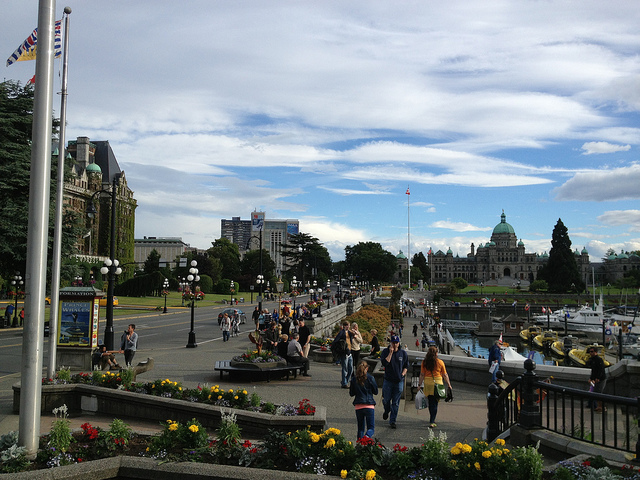Chip in to keep stories like these coming.
The Best and Worst Places to be a Woman In Canada 2015 ranks Canada’s 25 biggest cities based on the gaps in how men and women are faring in five key areas:
- economic security (as measured by gender gaps in employment, pay and the likelihood of living in poverty);
- education;
- health;
- representation in municipal governments and senior management roles; and
- personal security (as measured by rates of criminal harassment, sexual assault and intimate partner violence, which disproportionately affect women).
The study shows that Canada as a whole is doing well in terms of providing equal access to education and health services. Women’s education levels are greater than men’s in every area except the trades, but getting more education has not eliminated the gender gaps in economic participation and representation in leadership roles in municipal government or business. Canadian cities share another challenge: rates of sexual assault and domestic violence remain persistently high across the country, changing little over the last 20 years.
That said, the gender gap varies considerably across the country. Cities with a large public sector employer (like Victoria and Gatineau) tend to do well because the gender wage gap is much smaller in the public sector. Family policies like generous parental leave and publicly funded child care help women in Quebec balance work and family responsibilities, which is why cities in Quebec rank in the top 10. Cities whose economy is driven by construction and resources (like Edmonton and Calgary) rank near the bottom because of large gender gaps in employment and wages. The same goes for Kitchener-Cambridge-Waterloo, where the male-dominated tech sector is a major employer.
Kitchener gets the dubious honour of being the worst city to be a woman in Canada. Besides a large gender wage gap, Kitchener has much higher levels of poverty among women than men (17 per cent vs. 11 per cent) and some of the highest rates of domestic violence among the 25 big cities. Women are poorly represented on city councils (less than one-third of all councillors are female), and only one-third of senior managers in the area are women.
B.C.’s four biggest cities, Metro Vancouver, Greater Victoria, Kelowna and Abbotsford-Mission, rank in the top half. B.C. cities are doing particularly well when it comes to women’s representation in municipal government (coming close to parity on average) and in senior management, where 35-37 per cent of positions are held by women. B.C. cities also tend to have average or lower reported rates of domestic violence, though spousal homicides hit a five-year high in the province in 2014.
However, it’s too early to pat ourselves on the back. When it comes to the gender gap in economic participation and wages, B.C. is home to both the lowest gender gap (Victoria) and the highest (Kelowna) among Canada’s 25 biggest cities. Abbotsford-Mission ranks fourth from the bottom, with a large gender gap in employment and earnings, while Vancouver is in the middle of the pack at number 11. This is one of the areas where B.C. cities need to improve.
Victoria stands out as the city with the smallest gender gap in Canada. It’s the only city of the big 25 where women outnumber men among city councillors. When all Greater Victoria municipalities are considered, 45 per cent of elected officials are female — the closest any region comes to parity. The gap in men’s and women’s levels of employment is the smallest in the country, and the gender gap in employment earnings is smaller than average, though even in Victoria parity hasn’t been reached.
What can cities do to reduce the gender gap? Public policies that help women balance work and family caregiving responsibilities — such as $10-a-day child care and home support for seniors — will help.
However, closing the gender gap is not just the job of governments — business also has an important role to play.
Employers should examine their payrolls to see whether they pay women and men differently for the same work. Such exercises were recently undertaken by McMaster University and UBC, and both found gender gaps in professors’ wages. It’s unlikely they are the only employers with a gender pay gap in the country.
Moreover, employers need transparent performance evaluation and promotions practices to make sure that unconscious bias isn’t leading them to overlook the contributions of their female staff. Paying a living wage would also help — we know women are overrepresented in low-wage work, and 60 per cent of workers making less than $15/hour in B.C. are women.
The good news is that there are many great local initiatives aiming to close the gender gap that we can all learn from. What are some steps you’ve taken to make your workplace or community more inclusive and to enable every woman and man to reach their full potential?
—
More about the methodology: CCPA’s Senior Researcher Kate McInturff developed the ranking, which builds on global indexes of gender equality used by the World Economic Forum and the United Nations. It’s augmented to include measures of violence against women, which none of the international indices has been able to include so far (due to data limitations). As with any index, the average scores obscure significant differences in the experiences of Aboriginal and non-Aboriginal women, immigrant and visible minority women, women with disabilities, etc.
Photo: oklanica/flickr
Chip in to keep stories like these coming.




